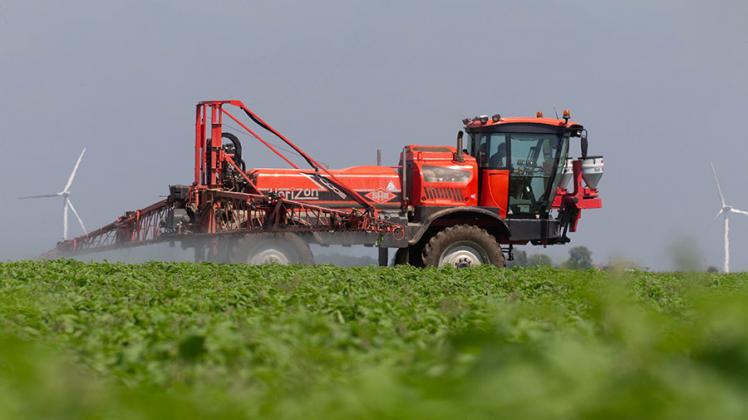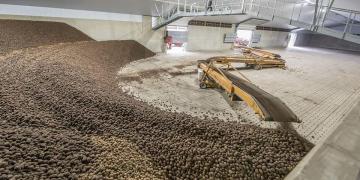Gran Bretaña: Why late blight management just got more complicated for 2024
A late blight genotype that is resistant to a second fungicide mode of action continues to spread through Europe, meaning British potato growers will need to take extra care when planning control strategies next year.

The Fight Against Blight (FAB) monitoring initiative, which looks for genetic changes in the late blight population and its sensitivity to key fungicides, delivered its latest results at the 2023 British Potato event (BP2023).
There is little change in the British population this year, with 36_A2 (51%) and 6_A1 (34%) still dominating the 830 genotypes isolated from samples sent to the James Hutton Institute (JHI) in Dundee for testing.
See also: How potato grower variably applies potash and magnesium
Further good news that 43_A1, a genotype resistant to carboxylic acid amide (CAA) fungicides such as mandipropamid and widespread in mainland Europe, has not yet been attributed to any outbreaks here in GB.
However, news from across the Channel is not so positive, with manufacturer Corteva confirming resistance in the 43_A1 lineage to its active substance oxathiapiprolin, contained in products like Zorvec Endavia.
David Cooke, JHI’s project lead at FAB, confirmed that the troublesome genotype has been isolated from a sample taken at Teagasc’s Carlow site in Ireland as it continues to spread across north-west Europe.
He says experience tells us that any aggressive genotypes originating in countries such as the Netherlands always jump to the UK eventually, so it is only a matter of time before it threatens British crops.
“Fungicide programmes are going to be even more challenging to plan,” he says. “We need to think ahead, assume it’s going to arrive, and adjust control strategies accordingly.”
European lessons
For Scottish Agronomy’s Eric Anderson, the industry needs only to look at the difference between Denmark and the Netherlands this year to see the best approach to late blight control next season.
As in the UK, late blight pressure in both countries was severe from late June onwards, when wetter weather started to prevail.
Dutch growers have traditionally practised “blocking”, a fungicide strategy where multiple sprays are applied in a row – typically two or three – containing the same active substance, before alternating to a different mode of action.
It is understood that in 2023, some Dutch farms applied three consecutive CAA fungicides, which failed to control 43_A1 and amplified the population. Then Zorvec Endavia was used to firefight outbreaks, against label guidance.
Zorvec Endavia contains oxathiapiprolin, co-formulated with CAA active benthiavalicarb, so oxathiapiprolin was effectively isolated and put under huge selection pressure.
This resulted in a further mutation of 43_A1 and selection of resistant isolates.
Preliminary results from the Europe-wide monitoring initiative Euroblight reveal that the 43_A1 genotype now makes up 63.9% of isolates in the Netherlands, up from just 2% just two years ago.
Eric says: “Dutch growers are reporting the worst blight epidemic for 30 years, and after the disease was found in crops, they broke every rule in the book with CAA and oxathiapiprolin use.
“In Denmark, with higher blight pressure and a narrower choice of chemistry, it was well controlled, because they followed best practice advice, which is to alternate and mix modes of action throughout the season.”
Proactive programmes
This year’s FAB fungicide insensitivity testing work, led by JHI’s Alison Lees, confirms that all current GB isolates, and some Danish samples of 43_A1 taken in 2022, are well controlled by the five actives tested.
These are ametoctradin, amisulbrom, oxathiapiprolin, propamocarb and zoxamide, which are all differing modes of action.
There are a further six modes of action available to potato growers for controlling potato late blight in GB, including multisite inhibitor mancozeb.
BASF has also brought a product to market for 2024 called Privest, which contains ametoctradin partnered with potassium phosphonates, with the latter component bringing yet another mode of action.
Alternation and mixing were unanimously advocated by the experts who spoke to Farmers Weekly at BP2023.
Fungicide strategies that make use of all these different modes of action should enable growers to do that.
David also points out that actives with past insensitivity issues still have a place. One example, fluazinam, is ineffective against genotype 37_A2.
However, 37_A2 has declined in prevalence in recent years, with only low levels found in 2023. Fluazinam is effective against all other genotypes, including 43_A1.
Metalaxyl-M, which doesn’t control 13_A2, is another active that has fallen out of programmes but is still effective against all other genotypes.
It could form a useful part of fungicide programmes if supported by an alternative mode of action.
“Fluazinam is a good partner product in programmes for 2024.
“Metalaxyl-M, although it seems like old news and we know there is resistance, it is still a very active systemic product and genotype 13_A2 is still low-frequency. It could still be [an option] next year.”
CAA fungicide advice
CAA fungicide products such as Revus, which is not effective against the 43_A1 lineage in mainland Europe, also have a place, but manufacturer Syngenta’s Andy Cunningham tells Farmers Weekly that advice on use of Revus will change for 2024.
Although Fungicide Resistance Action Group (FRAG) guidance allows two consecutive sprays of Revus, Syngenta’s best practice will be to only use Revus with an effective tank mix partner and for it to be applied in alternation with fungicides of an alternative mode of action.
This will be a more effective anti-resistance strategy and Andy named a wide range of partners that perform well with Revus in the company’s trials during 2023, including mancozeb.
“While we have it, let’s utilise it. It is a very good mixing partner, especially from a resistance management point of view,” he notes.
With the confirmation of resistance to oxathiapiprolin in Europe a recent development after its own internal investigation, Corteva was reluctant to communicate any updated advice on use of its products containing the active in 2024.
In a statement, it reiterated that no resistant isolates had been found in the UK, but stressed that there was no room for complacency, and it was working with industry stakeholders to issue the right advice before the next British potato crop was planted.
Independent potato agronomist John Keer of Richard Austin Agriculture says he will still use oxathiapiprolin, as it remains one of the top performing actives in his trials against dominant genotypes.
“But as always, we do need to maintain a strong anti-resistance strategy, mixing, alternating, and using mancozeb as much as possible,” he says.
“Mancozeb would be the most technically sound and cost-effective partner for oxathiapiprolin.”
Mancozeb availability
The continued availability of mancozeb is now critical, with some speculating that its use is a big factor in GB avoiding the same control issues being experienced in mainland Europe.
UPL is the main manufacturer of mancozeb, and its technical support manager Geoff Hailstone says at the moment the active is registered until June 2026 in Great Britain, with an assessment by UK regulators ongoing.
He adds that UPL is fully supporting the approval process with the necessary data and information needed by CRD, and it could be re-registered, but equally there is no guarantee of its continued availability in either the short or long term.
“We are assuming that we will have it at least for next season, so are bringing product in.
“We are taking it a year at the time at the moment and feedback on the needs of the industry is key to securing enough product, so talk to your local distributor,” says Geoff.
Import warning
Finally, Eric Anderson warns that the very high incidence of foliar and tuber blight in continental seed and a likely shortfall in British seed this year means there is a real risk of importing 43_A1 into England with latent infection.
If anti-resistance strategies aren’t followed from the start of fungicide programmes where infected seed is planted, it could allow the genotype to gain a foothold quickly.
“The tolerance for tuber blight in Basic seed potatoes and certified seed potatoes produced in England is 0.5%, and about one in 200 blighted tubers will typically still emerge after planting,” he says.
“At average planting densities, that could result in one or two blight foci in a field.”
Fuente: https://www.fwi.co.uk/arable/potatoes/why-late-blight-management-just-got-more-complicated-for-2024




